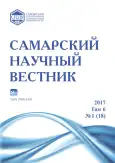Bio-ecological features of some rare plants fruits in the Samara Region
- Authors: Kotelnikova M.G.1
-
Affiliations:
- Samara National Research University
- Issue: Vol 6, No 1 (2017)
- Pages: 41-46
- Section: 03.02.00 – General Biology
- URL: https://journals.rcsi.science/2309-4370/article/view/21639
- DOI: https://doi.org/10.17816/snv201761108
- ID: 21639
Cite item
Full Text
Abstract
The paper presents some preliminary results of the monitoring of Fritillaria meleagroides Partin ex Schult. et Schult. fil. and Tulipa biebersteiniana Schult. et Schult. fil. plants (category of rare and endangered plant species). The results of the field study fulfilled in 2012–2016 in two population groups of quarter 80 and cenopopulation of quarter 69 in the Krasnosamarsky forestry (Samara Region) were used to determine morphometric parameters of plant species. The data also helped us to assess the variability level and to make a comparison with plant quantitative traits given in the literature. It has been found that the sample indicators fit into the range of values specified in literature sources, with a significant proportion of «large» fruit 2,0–3,0 cm in length. The dynamics of the fruit size of Fritillaria meleagroides Partin ex Schult. et Schult. fil. and Tulipa biebersteiniana Schult. et Schult. fil. plants in population groups of quarter 80, as a whole, has general patterns in the difference during some seasons of vegetation. Prevailing values of fruit length of plants in cenopopulations of quarter 69 changed slightly according to year of vegetation, these populations are more resistant and numerous comparing with the populations of quarter 80. As for variability of signs, the values of fruit length and width coefficients of variation does not exceed 25% for Fritillaria meleagroides Partin ex Schult. et Schult. fil. plants and 20% for Tulipa biebersteiniana Schult. et Schult. fil. plants which is optimal for this type of indicators and is consistent with the bioecological specificity of fruit plant. The conditions of ecosystems in 69 and 80 quarters of Krasnosamarsky forestry are favorable for the vegetation of two species plants, the successful preservation and restoration in natural communities can be in the absence of anthropogenic factors limits.
Full Text
##article.viewOnOriginalSite##About the authors
Mariya Gennadevna Kotelnikova
Samara National Research University
Author for correspondence.
Email: rizik230991@yandex.ru
postgraduate student of Ecology, Botany and Nature Protection Department
Russian Federation, SamaraReferences
- Красная книга Самарской области. Т. 1. Редкие виды растений, лишайников и грибов / под ред. чл.-корр. РАН Г.С. Розенберга и С.В. Саксонова. Тольятти: ИЭВБ РАН. 2003. 400 с.
- Черепанов С.К. Сосудистые растения России и сопредельных государств (в пределах бывшего СССР). Русское издание. СПб.: Мир и семья, 1995. 992 с.
- Иллюстрированный определитель растений Средней России. Т. 1. Папоротники, хвощи, плауны, голосеменные, покрытосеменные (однодольные) / И.А. Губанов, К.В. Киселёва, В.С. Новиков, В.Н Тихомиров. М.: Т-во научных изданий КМК, Ин-т технологических исследований. 2003. С. 457–476.
- Маевский П.Ф. Флора средней полосы европейской части России. М.: Товарищество научных изданий КМК, 2006. С. 156–157.
- Флора Сибири. Новосибирск: Наука, 1987. Т. 4. С. 101.
- Котельникова М.Г. К оценке биоэкологических особенностей растений тюльпана Биберштейна (Tulipa biebersteiniana Shult. et Shult. fil.) в модельных биотопах Красносамарского лесничества // Самарский научный вестник. 2016. № 3 (16). С. 30–35.
- Котельникова М.Г. К оценке некоторых морфометрических показателей растений рябчика шахматовидного (Fritillaria meleagroides partin ex schult. Et schult. Fill) с модельных биотопов красносамарского леса // Приоритетные научные направления: от теории к практике: мат-лы междунар. конф. Новосибирск, 2016. С. 36–39.
- Флора Нижнего Поволжья. Т. 1. (споровые, голосеменные, однодольные). М.: Товарищество научных изданий КМК, 2006. С. 363.
- Энциклопедия декоративных садовых растений [Электронный ресурс] // http://flower.onego.ru/lukov/ tulipa/19.html.
- Красная книга Курганской области. Изд. 2-е. Курган: Изд-во Курганского гос. ун-та, 2012. 448 с.
- Травянистые растения СССР // Ю.Е. Алексеев, В.Н. Вехов, Г.П. Гапочка, Ю.К. Дундин и др. М.: Мысль, 1971. С. 295.
Supplementary files










